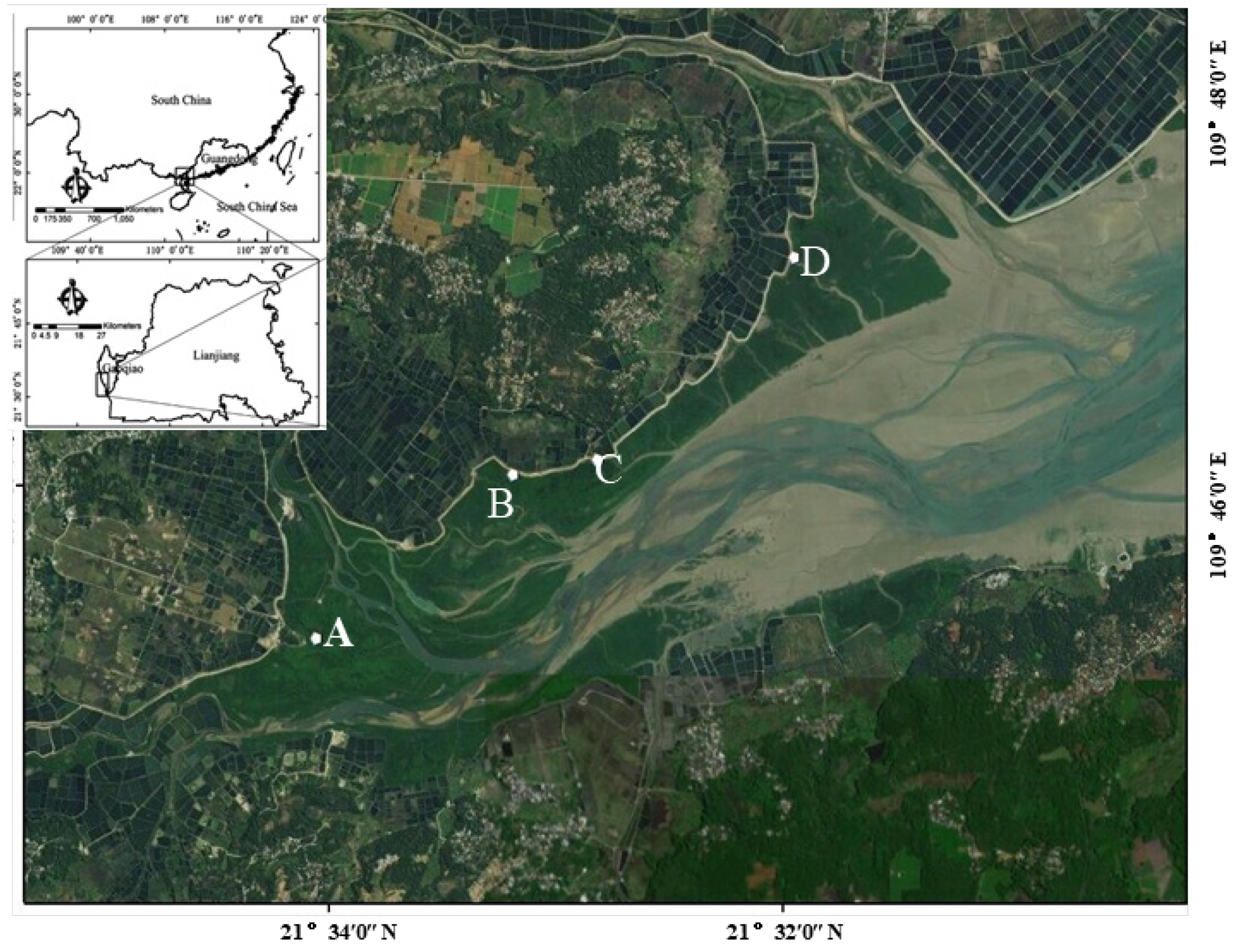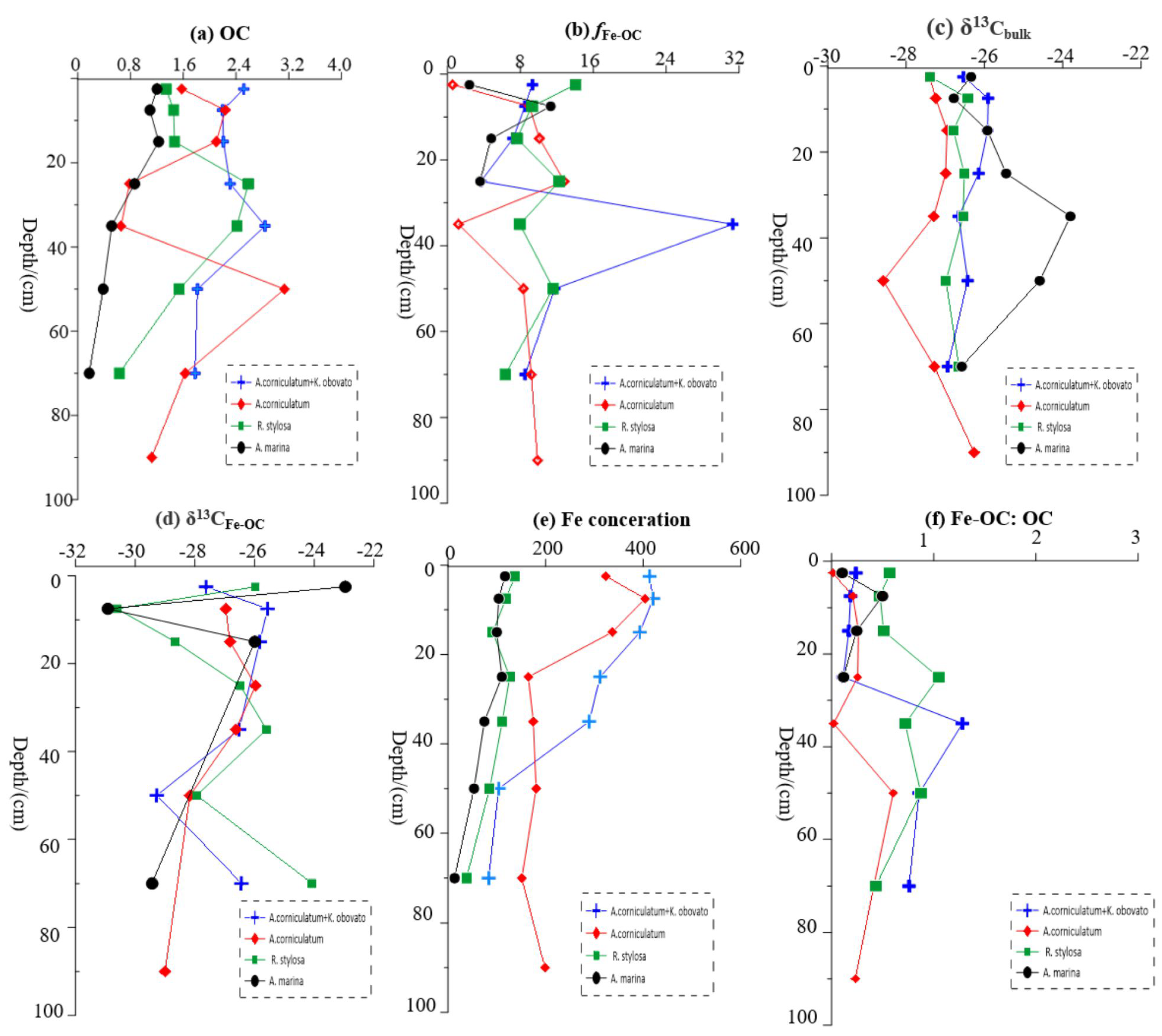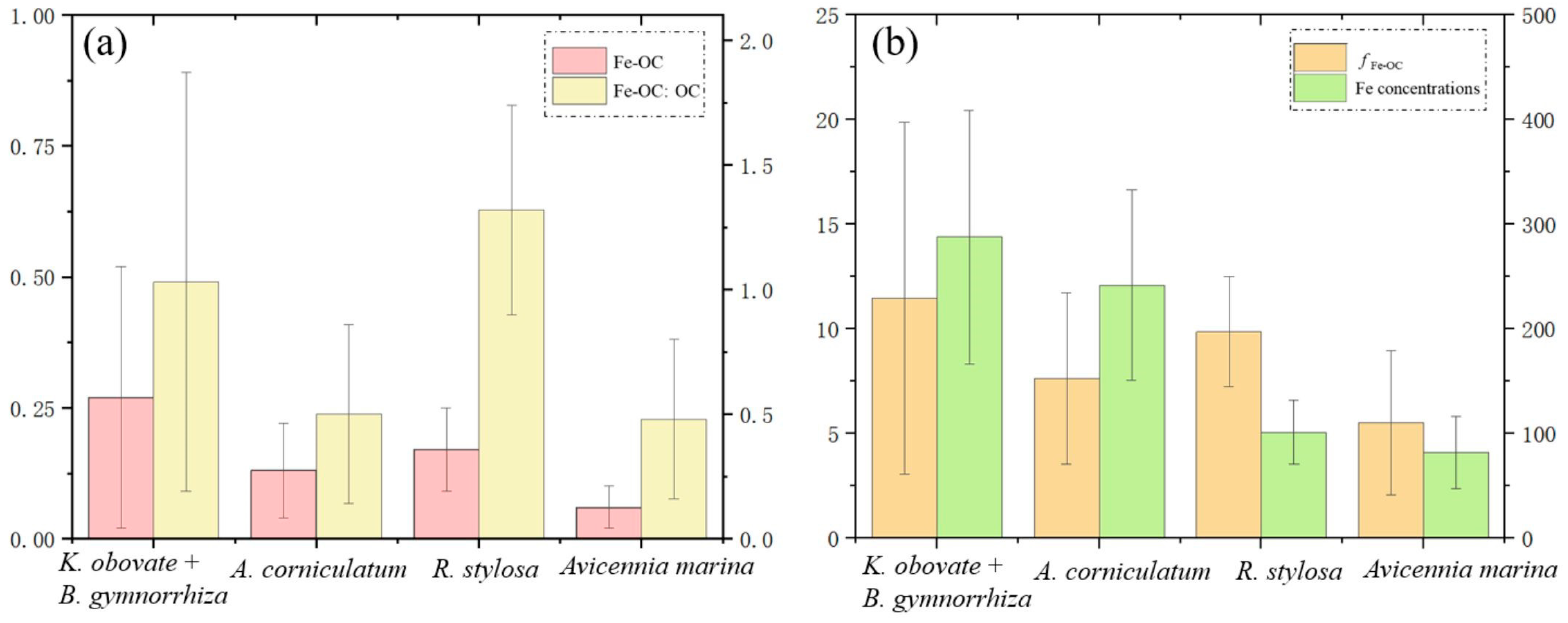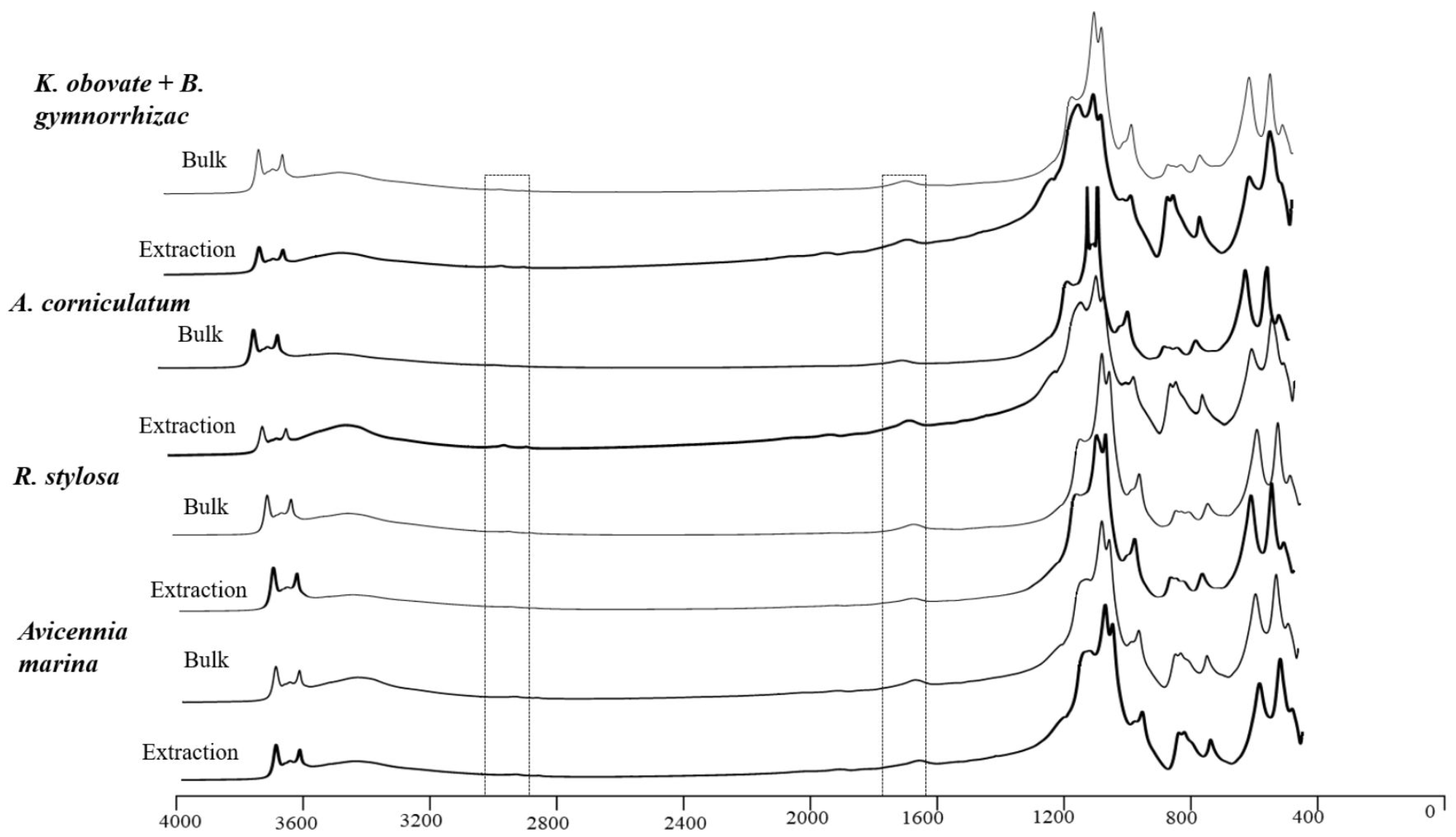The Role of Iron Minerals in the Preservation of Organic Carbon in Mangrove Sediments
Abstract
1. Introduction
2. Sample and Methods
2.1. Sample Sites
2.2. Sediment Collection
2.3. Mineral Composition
2.4. OC and Stable Carbon Isotope Analyses
2.5. Iron Extraction and Fe-OC Analyses
2.6. The Molecular Composition of Fe-OC
2.7. Statistical Analyses
3. Experimental Results
3.1. Mineral Composition
3.2. Bulk OC Concentration and Carbon Isotope Signatures
3.3. Characterization of Fe-OC and Carbon Isotope Values
3.4. Iron Concentration
3.5. Relationship between Iron Content and OC Concentration
3.6. The Molecular Composition of Fe-OC
4. Discussion
4.1. Percentage of Iron-Bound Carbon and Influencing Factors
4.2. Binding Mechanism of Iron and OC
4.3. Carbon Isotope and Molecular Characteristics of Fe-OC
4.4. Estimation of the Burial Rate of Fe-OC
5. Conclusions
Author Contributions
Funding
Data Availability Statement
Acknowledgments
Conflicts of Interest
References
- Atwood, T.B.; Connolly, R.M.; Almahasheer, H. Global patterns in mangrove soil carbon stocks and losses. Nat. Clim. Chang. 2017, 7, 523–528. [Google Scholar] [CrossRef]
- Alongi, D.M. Carbon Sequestration in Mangrove Forests. Carbon Manag. 2012, 3, 313–322. [Google Scholar] [CrossRef]
- Duarte, C.M.; Middelburg, J.J.; Caraco, N. Major role of marine vegetation on the oceanic carbon cycle. Biogeosciences 2005, 2, 1–8. [Google Scholar] [CrossRef]
- Donato, D.C.; Kauffman, J.B.; Murdiyarso, D.; Kurnianto, S.; Stidham, M.; Kanninen, M. Mangroves among the most carbon-rich forests in the tropics. Nat. Geosci. 2011, 4, 293–297. [Google Scholar] [CrossRef]
- Hedges, J.I.; Keil, R.G. Sedimentary organic matter preservation: An assessment and speculative synthesis. Mar. Chem. 1995, 49, 81–115. [Google Scholar] [CrossRef]
- Faust, J.C.; Tessin, A.; Fisher, B.J.; Zindorf, M.; Papadaki, S.; Hendry, K.R.; Doyle, K.A.; März, C. Millennial scale persistence of organic carbon bound to iron in Arctic marine sediments. Nat. Commun. 2021, 12, 275. [Google Scholar] [CrossRef] [PubMed]
- Boudot, J.P.; Hadj, A.B.; Steiman, R.; Seigle-Murandi, F. Biodegradation of synthetic organo-metallic complexes of iron and aluminium with selected metal to carbon ratios. Soil Biol. Biochem. 1989, 21, 961–966. [Google Scholar] [CrossRef]
- Chen, J.; Hu, Y.; Hall, S.J.; Hui, D.; Li, J.; Chen, G.; Sun, L.; Zhang, D.; Deng, Q. Increased interactions between iron oxides and organic carbon under acid deposition drive large increases in soil organic carbon in a tropical forest in southern China. Biogeochemistry 2022, 158, 287–301. [Google Scholar] [CrossRef]
- Che, M.; Gong, Y.; Xu, M.; Kang, C.; Lv, C.; He, S.; Zheng, J. Effects of elevation and slope aspect on the distribution of the soil organic carbon associated with Al and Fe mineral phases in alpine shrub–meadow soil. Sci. Total Environ. 2021, 753, 141933. [Google Scholar] [CrossRef]
- Hu, J.; Zeng, Q.; Chen, H.; Dong, H. Effect of bacterial cell addition on Fe (III) reduction and soil organic matter transformation in a farmland soil. Geochim. Cosmochim. Acta. 2022, 325, 25–38. [Google Scholar] [CrossRef]
- Mu, C.C.; Zhang, T.J.; Zhao, Q.; Gao, H.; Zhong, W.; Su, H.; Wu, Q.B. Soil organic carbon stabilization by iron in permafrost regions of the Qinghai-Tibet Plateau. Geophys. Res. Lett. 2016, 43, 286–294. [Google Scholar] [CrossRef]
- Peter, S.; Sobek, S. High variability in iron-bound organic carbon among five boreal lake sediments. Biogeochemistry 2018, 139, 19–29. [Google Scholar] [CrossRef]
- Lalonde, K.; Mucci, A.; Ouellet, A.; Gelinas, Y. Preservation of organic matter in sediments promoted by iron. Nature 2012, 483, 198–200. [Google Scholar] [CrossRef] [PubMed]
- Ma, W.W.; Zhu, M.X.; Yang, G.P.; Li, T. Iron geochemistry and organic carbon preservation by iron (oxyhydr) oxides in surface sediments of the East China Sea and the south Yellow Sea. J. Mar. Syst. 2018, 178, 62–74. [Google Scholar] [CrossRef]
- Wang, D.; Zhu, M.X.; Yang, G.P.; Ma, W.W. Reactive iron and iron-bound organic carbon in surface sediments of the river-dominated Bohai Sea (China) Versus the Southern Yellow Sea. J. Geophys. Res. Biogeosci. 2019, 124, 79–98. [Google Scholar] [CrossRef]
- Longman, J.; Gernon, T.M.; Palmer, M.R.; Manners, H.R. Tephra deposition and bonding with reactive oxides enhances burial of organic carbon in the Bering Sea. Global Biogeochem. Cycles 2021, 35, e2021GB007140. [Google Scholar] [CrossRef]
- Salvadó, J.A.; Tesi, T.; Andersson, A.; Ingri, J.; Dudarev, O.V.; Semiletov, I.P.; Gustafsson, O. Organic carbon remobilized from thawing permafrost is resequestered by reactive iron on the Eurasian Arctic Shelf. Geophys. Res. Lett. 2015, 42, 8122–8130. [Google Scholar] [CrossRef]
- Ghaisas, N.A.; Maiti, K.; Roy, A. Iron-Mediated Organic Matter Preservation in the Mississippi River-Influenced Shelf Sediments. J. Geophys. Res-Biogeo. 2021, 126, e2020JG006089. [Google Scholar] [CrossRef]
- Zhao, B.; Yao, P.; Bianchi, T.S.; Cui, X.Q.; Zhang, X.W.; Huang, X.Y.; Schroeder, C.; Zhao, J.; Yu, Z.G. The role of reactive iron in the preservation of terrestrial organic carbon in estuarine sediments. J. Geophys. Res-Biogeo. 2018, 123, 3556–3569. [Google Scholar] [CrossRef]
- Sirois, M.; Couturier, M.; Barber, A.; Gelinas, Y.; Chaillou, G. Interactions between iron and organic carbon in a sandy beach subterranean estuary. Mar. Chem. 2018, 202, 86–96. [Google Scholar] [CrossRef]
- Zhao, B.; Yao, P.; Bianchi, T.S.; Shields, M.R.; Cui, X.Q.; Zhang, X.W.; Huang, X.Y.; Schroeder, C.; Zhao, J.; Yu, Z.G. Preferential preservation of pre-aged terrestrial organic carbon by reactive iron in estuarine particles and coastal sediments of a large river-dominated estuary. Geochim. Cosmochim. Acta. 2023, 345, 34–49. [Google Scholar] [CrossRef]
- Sun, C.H.; Zhu, M.X.; Ma, W.W.; Sun, Z.L.; Zhang, X.R.; Ding, K.Y.; Liu, S.H. Examining bulk and iron-associated organic carbon through depth in margin sea sediments (China) under contrasting depositional settings: Chemical and NEXAFS spectral characterization. J Mar. Syst. 2020, 207, 103344. [Google Scholar] [CrossRef]
- Bai, J.; Luo, M.; Yang, Y.; Xiao, S.; Zhai, Z.; Huang, J. Iron-bound carbon increases along a freshwater−oligohaline gradient in a subtropical tidal wetland. Soil Biol. Biochem. 2021, 154, 108128. [Google Scholar] [CrossRef]
- Shields, M.R.; Bianchi, T.S.; Gélinas, Y.; Allison, M.A.; Twilley, R. Enhanced terrestrial carbon preservation promoted by reactive iron in deltaic sediments. Geophys. Res. Lett. 2016, 43, 1149–1157. [Google Scholar] [CrossRef]
- Longman, J.; Faust, J.C.; Bryce, C.; Homoky, W.B.; Marz, C. Organic carbon burial with reactive iron across global environments. Glob. Biogeochem. Cycles 2022, 36, e2022GB007447. [Google Scholar] [CrossRef]
- Bouillon, S.; Borges, A.V.; Castañeda-Moya, E.; Diele, K.; Dittmar, T.; Duke, N.C.; Kristensen, E.; Lee, S.Y.; Marchand, C.; Middelburg, J.; et al. Mangrove production and carbon sinks: A revision of global budget estimates. Global Biogeochem. Cycles 2008, 22, 2. [Google Scholar] [CrossRef]
- Lin, P. Ecological notes on mangroves in southeast coast of China including Taiwan Province and Hainan Island. Acta Ecol Sin. 1981, 1, 283–290. [Google Scholar]
- Hong, P.N.; San, H.T. Mangroves of Vietnam; IUCN. The World Conservation Union: Bangkok, Thailand, 1993; p. 193. [Google Scholar]
- Mehra, O.P.; Jackson, M.L. Iron oxide removal from soils and clays by a dithionite–citrate system buffered with sodium bicarbonate. In Clays and Clay Minerals; Pergamon: Oxford, UK, 2013; pp. 317–327. [Google Scholar]
- Dicen, G.P.; Navarrete, I.A.; Rallos, R.V.; Salmo, S.G.; Garcia, M.C.A. The role of reactive iron in long-term carbon sequestration in mangrove sediments. J. Soils Sediments. 2019, 19, 501–510. [Google Scholar] [CrossRef]
- Gleason, S.M.; Ewel, K.C. Organic matter dynamics on the forest floor of a micronesian mangrove forest: An investigation of species composition Shifts1. Biotropica 2002, 34, 190–198. [Google Scholar] [CrossRef]
- Sherman, R.E.; Fahey, T.J.; Martinez, P. Spatial patterns of biomass and aboveground net primary productivity in a mangrove ecosystem in the Dominican Republic. Ecosystems 2003, 6, 384–398. [Google Scholar] [CrossRef]
- Wang, G.; Guan, D.; Peart, M.R.; Chen, Y.; Peng, Y. Ecosystem carbon stocks of mangrove forest in Yingluo Bay, Guangdong Province of South China. For. Ecol. Manag. 2013, 310, 539–546. [Google Scholar] [CrossRef]
- Fisher, B.J.; Moore, O.W.; Faust, J.C.; Peacock, C.L.; Marz, C. Experimental evaluation of the extractability of iron bound organic carbon in sediments as a function of carboxyl content. Chem. Geol. 2020, 556, 119853. [Google Scholar] [CrossRef]
- Johnson, D.W.; Todd, D.E. Relationships among iron, aluminum, carbon, and sulfate in a variety of forest soils. Soil Sci. Soc. Am. J. 1983, 47, 792–800. [Google Scholar] [CrossRef]
- Mikutta, R.; Mikutta, C.; Kalbitz, K.; Torn, M. Biodegradation of forest floor organic matter bound to minerals via different binding mechanisms. Geochim. Cosmochim. Acta. 2007, 71, 2569–2590. [Google Scholar] [CrossRef]
- Gu, B.; Schmitt, J.; Chen, Z.; Liang, L. Adsorption and desorption of natural organic matter on iron oxide: Mechanisms and models. Environ. Sci. Technol. 1994, 28, 38–46. [Google Scholar] [CrossRef] [PubMed]
- Chen, C.; Dynes, J.J.; Wang, J.; Sparks, D.L. Properties of Fe-organic matter associations via coprecipitation versus adsorption. Environ. Sci. Technol. 2014, 48, 13751–13759. [Google Scholar] [CrossRef]
- Han, L.; Sun, K.; Keiluweit, M.; Yang, Y.; Jin, J.; Sun, H.; Wu, F.; Xing, B. Mobilization of ferrihydrite-associated organic carbon during Fe reduction: Adsorption versus coprecipitation. Chem. Geol. 2019, 503, 61–68. [Google Scholar] [CrossRef]
- Riedel, T.; Zak, D.; Biester, H.; Dittmar, T. Iron traps terrestrially derived dissolved organic matter at redox interfaces. Proc. Natl. Acad. Sci. USA 2013, 110, 10101–10105. [Google Scholar] [CrossRef] [PubMed]
- Barber, A.; Brandes, J.; Leri, A.; Lalonde, K.; Balind, K.; Wirick, S.; Wang, J.; Gelinas, Y. Preservation of organic matter in marine sediments by inner-sphere interactions with reactive iron. Sci. Rep. 2017, 7, 366. [Google Scholar] [CrossRef]
- He, T.R. Preservation of Organic Carbon Promoted by Iron in Estuarine Wetland Sediments; East China Normal University: Shanghai, China, 2021. [Google Scholar]
- Alongi, D.M. Carbon cycling and storage in mangrove forests. Annu. Rev. Mar. Sci. 2014, 6, 195–219. [Google Scholar] [CrossRef]
- Middelburg, J.J.; Nieuwenhuize, J. Carbon and nitrogen stable isotopes in suspended matter and sediments from the Schelde Estuary. Mar. Chem. 1998, 60, 217–225. [Google Scholar] [CrossRef]
- Fontugne, M.R.; Jouanneau, J.M. Modulation of the particulate organic carbon flux to the ocean by a macrotidal estuary: Evidence from measurements of carbon isotopes in organic matter from the Gironde system. Estuar. Coast. Shelf Sci. 1987, 24, 377–387. [Google Scholar] [CrossRef]
- Kendall, C.; Silva, S.R.; Kelly, V.J. Carbon and nitrogen isotopic compositions of particulate organic matter in four large river systems across the United States. Hydrol. Process 2001, 15, 1301–1346. [Google Scholar] [CrossRef]
- Parikh, S.J.; Goyne, K.W.; Margenot, A.J. Soil chemical insights provided through vibrational spectroscopy. Adv. Agron. 2014, 126, 1–148. [Google Scholar]
- Zhao, Q.; Poulson, S.R.; Obrist, D.; Sumaila, S.; Dynes, J.J.; McBeth, J.M.; Yang, Y. Iron-bound organic carbon in forest soils: Quantification and characterization. Biogeosciences 2016, 13, 4777–4788. [Google Scholar] [CrossRef]
- Madejová, J. FTIR techniques in clay mineral studies. Vib. Spectrosc. 2003, 31, 1–10. [Google Scholar] [CrossRef]
- Senesi, N.; D’Orazio, V.; Ricca, G. Humic acids in the first generation of EUROSOILS. Geoderma 2003, 116, 325–344. [Google Scholar] [CrossRef]
- Wang, F.; Sanders, C.J.; Santos, I.R.; Tang, J.; Schuerch, M.; Kirwan, M.L.; Kopp, R.E.; Zhu, K.; Li, X.; Yuan, J.; et al. Global blue carbon accumulation in tidal wetlands increases with climate change. Natl. Sci. Rev. 2021, 8, nwaa296. [Google Scholar] [CrossRef]
- Mcleod, E.; Chmura, G.L.; Bouillon, S.; Salm, R.; Björk, M.; Duarte, C.M.; Lovelock, C.E.; Schlesinger, W.H.; Silliman, B.R. A blueprint for blue carbon: Toward an improved understanding of the role of vegetated coastal habitats in sequestering CO2. Front. Ecol. Environ. 2011, 9, 552–560. [Google Scholar] [CrossRef]
- Wang, G.; Guan, D.; Xiao, L.; Peart, M.R. Ecosystem carbon storage affected by intertidal locations and climatic factors in three estuarine mangrove forests of South China. Reg. Environ. Chang. 2019, 19, 1701–1712. [Google Scholar] [CrossRef]
- Yu, C.; Feng, J.; Liu, K.; Wang, G.; Zhu, Y.; Chen, H.; Guan, D. Changes of ecosystem carbon stock following the plantation of exotic mangrove Sonneratia apetala in Qi’ao Island, China. Sci. Total Environ. 2020, 717, 137142. [Google Scholar] [CrossRef] [PubMed]







| Sampling Site | Community Composition | Elevation (m) | Longitude | Latitude |
|---|---|---|---|---|
| A | Kandelia obovate + Bruguiear gymnorrhiza | 1.98 | 109.7559 | 21.5678 |
| B | Aegiceras corniculatum | 2.2 | 109.7678 | 21.5534 |
| C | Rhizophora stylosa | 1.84 | 109.7689 | 21.54727 |
| D | Avicennia marina | 1.29 | 109.7837 | 21.5329 |
Disclaimer/Publisher’s Note: The statements, opinions and data contained in all publications are solely those of the individual author(s) and contributor(s) and not of MDPI and/or the editor(s). MDPI and/or the editor(s) disclaim responsibility for any injury to people or property resulting from any ideas, methods, instructions or products referred to in the content. |
© 2024 by the authors. Licensee MDPI, Basel, Switzerland. This article is an open access article distributed under the terms and conditions of the Creative Commons Attribution (CC BY) license (https://creativecommons.org/licenses/by/4.0/).
Share and Cite
Li, K.; Huang, H.; Dong, D.; Zhang, S.; Yan, R. The Role of Iron Minerals in the Preservation of Organic Carbon in Mangrove Sediments. Water 2024, 16, 1011. https://doi.org/10.3390/w16071011
Li K, Huang H, Dong D, Zhang S, Yan R. The Role of Iron Minerals in the Preservation of Organic Carbon in Mangrove Sediments. Water. 2024; 16(7):1011. https://doi.org/10.3390/w16071011
Chicago/Turabian StyleLi, Kang, Huamei Huang, Di Dong, Shengpeng Zhang, and Ran Yan. 2024. "The Role of Iron Minerals in the Preservation of Organic Carbon in Mangrove Sediments" Water 16, no. 7: 1011. https://doi.org/10.3390/w16071011
APA StyleLi, K., Huang, H., Dong, D., Zhang, S., & Yan, R. (2024). The Role of Iron Minerals in the Preservation of Organic Carbon in Mangrove Sediments. Water, 16(7), 1011. https://doi.org/10.3390/w16071011






